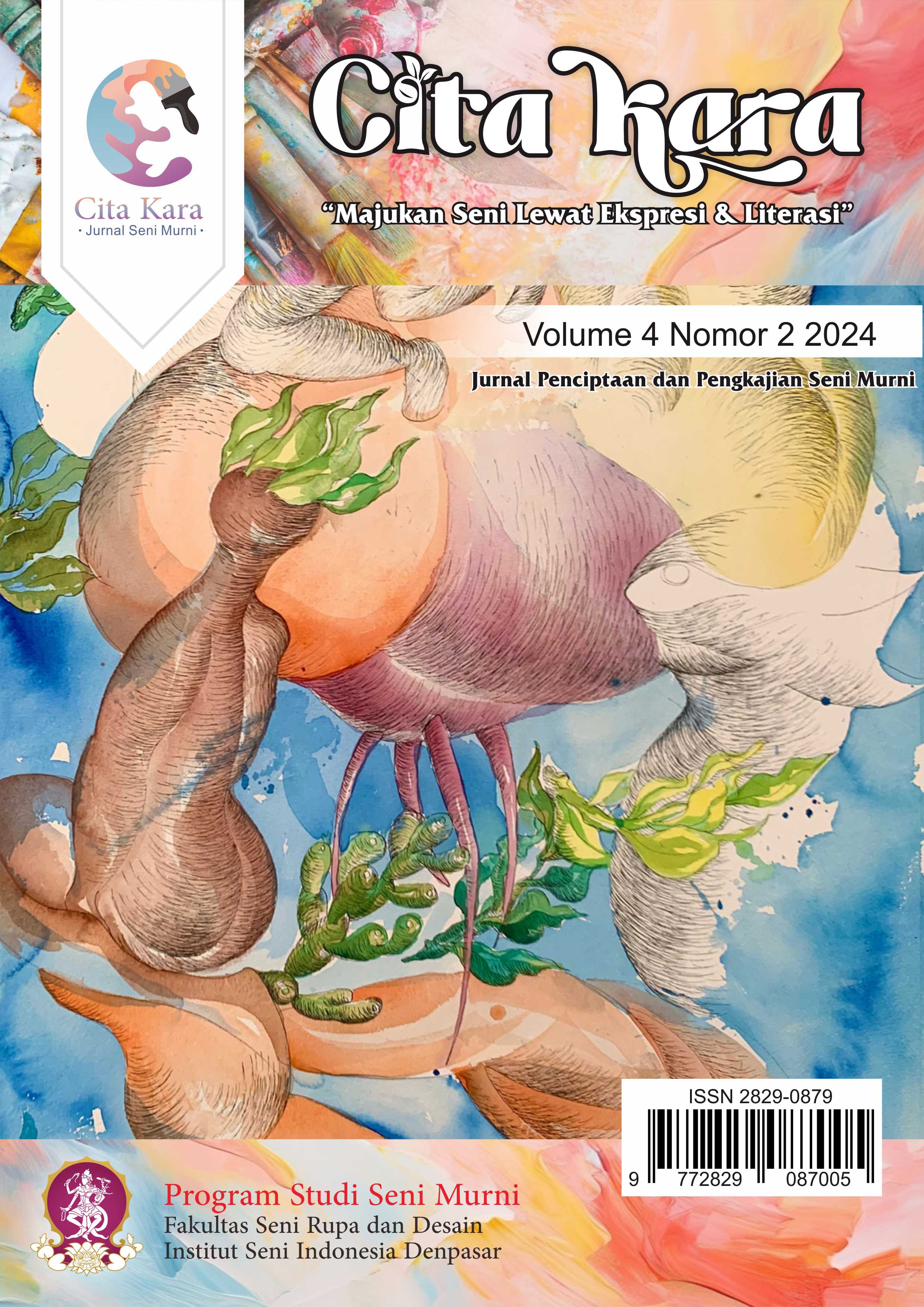Calonarang Mythology
DOI:
https://doi.org/10.59997/ctkr.v4i2.3383Keywords:
Calonarang mythology, folklore, paintingAbstract
Calonarang mythology depicts the story of Queen Nata Ing Girah (ruler in the village of Girah) which is considered scary because it has magical powers and supernatural. Various mythical stories and magical rituals always color the trail Airlangga in Kahuripan, East Java during the 11th century Javanese Hindu period. Research This aims to create and analyze Calonarang's mythological themes in the work art painting. Therefore, the author raised this story into the form of a work of art painting in this Final Project in partnership with Sanggar Wasundari Kamasan Klungkung Bali. Calonarang Mythology research problems in creation. This is the concept of painting that depicts the Calonarang Mythology, what is the process of creating a work of painting depicting mythology Calonarang, and how Calonarang Mythology paintings look like. Method The research used in this writing is text analysis and study literature. The results of this research are works of art with a mythology theme Calonarang with an explanation of the concept, origins of Calonarang mythology, characteristics main characters, and important events in the story are realized in paintings.
References
Setem, I. W. (2021). Pedoma Penulisan Skripsi Tugas Akhir Progran MBKM ISI Denpasar. Jalan Nusa Indah, Denpasar 80235: ISI Denpasar.
Toeti, Heraty. (2012). Judul Calon Arang (dalam bahasa Indonesia). Yayasan Pustaka Obor Indonesia. ISBN 9789794618332.
Bellamora, Ladha. (2022). Kisah Calonarang Sebagai Inspirasi Penciptaan Karya Seni Lukis.
http://digilib.isi.ac.id/12961/4/Jurnal_Landha%20Bellamora.pdf .
di akses tanggal 4 September 2023
Calonarang, Takasu. (2020). Murid Calonarang.
https://sejarahharirayahindu.blogspot.com/2020/02/murid-calonarang.html
di
Rosa, Nikita. (2023, July 26). Seni Rupa Adalah: Unsur, Jenis, Fungsi, dan Contohnya.
https://www.detik.com/edu/detikpedia/d-6840762/seni-rupa-adalah-unsur-jenis-fungsi-dan-contohnya
Kanta, I. M.(1977).“Proses Tradisional Wayang kamasan”.
Maheswari, Ni. K. Ratih. (2023) “perkembangan wayang kamasan dan diakui oleh UNESCO”.
Adiguna., Budiarta, I. Dewa. Gede., & Yugus. Gede. A. A. (2022). Jurnal Karya Ilmiah “Motif Ornamen Bali Sebagai Sumber Inspirasi Dalam Penciptaan Seni Lukis Wayang Kamasan”. Institut Seni Indonesia Denpasar.
Sachari. (1989:Hal.18). “Pola pertumbuhan estetik, prinsip kejelasan, prinsip pertalian, prinsip keseragaman, dan prinsip kontradiksi”.
Stefan Arvidsson, Aryan Idols. (2006). Indo-European Mythology as Ideology and Science, University of Chicago Press. ISBN 0-226-02860-7.
https://id.wikipedia.org/wiki/Mitologi
Roland, Barthes. (1957). Mythologies.
https://id.wikipedia.org/wiki/Mitologi
Armstrong, Karen. (2006). "A Short History of Myth". Knopf Canada.
https://id.wikipedia.org/wiki/Mitologi
Wirawan, Komang Indra Wirawan. (2019). Calonarang: Ajaran Tersembunyi di Balik Tarian Mistis, Bali Wisdom.
www.kompas.com
Downloads
Published
Issue
Section
License
Copyright (c) 2024 I Putu Deva Maha Putra, I Made Jodog, I Wayan Mudana

This work is licensed under a Creative Commons Attribution 4.0 International License.









